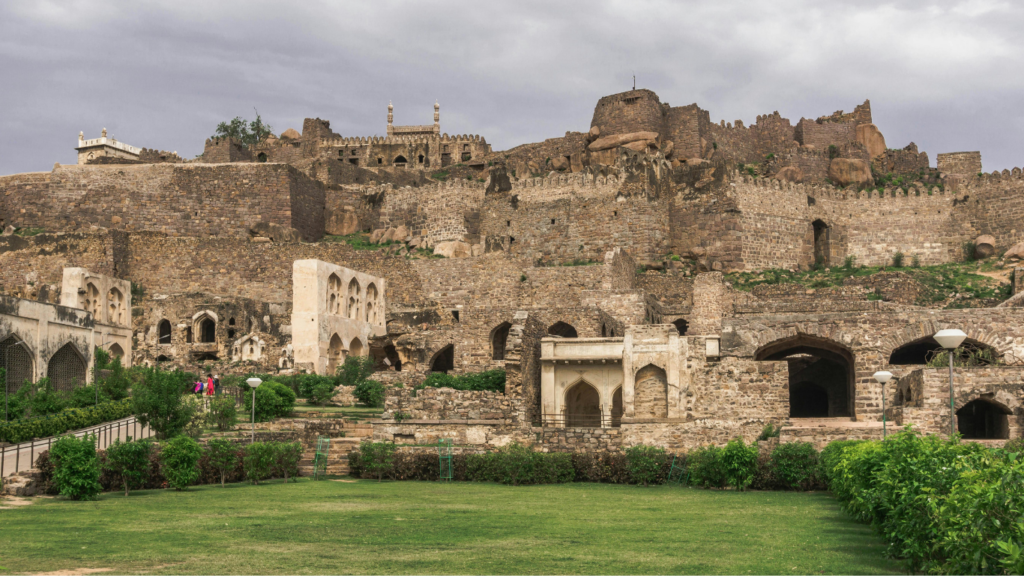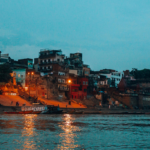A Glimpse into Golconda’s Grandeur
Golconda Fort, a historic gem in Hyderabad is a bustling hub of trade, power, and culture. Today, it’s a treasure for anyone who loves history or just wants to soak in something grand. The fort’s towering bastions, intricate carvings, and clever designs—like the famous acoustic system—make it a must-see. Whether you’re a local or a traveler, Golconda’s charm pulls you in, whispering tales of kings, battles, and diamonds. It’s not just a place; it’s a journey back in time, where every stone has a story to tell. Plan a visit, and let this majestic fort surprise you with its beauty and mystery.
The Fort’s Fascinating History
Golconda’s story begins in the 11th century as a simple mud fort called Mankal, built by the Kakatiya Dynasty. It wasn’t until the Bahmani Sultans took over in the 14th century that it started to grow. The real magic happened under the Qutb Shahi Dynasty, who turned it into a grand fortress between 1518 and 1687. They made Golconda their capital, filling it with palaces, mosques, and markets. It was a golden era, with the fort buzzing as a diamond trade center—think Kohinoor and Hope Diamond! But in 1687, Mughal Emperor Aurangzeb stormed in after a long siege, and the fort’s glory faded. Today, it stands as a beautiful ruin, carefully preserved by the Archaeological Survey of India. Wandering through, you can almost hear the echoes of royal processions and clashing swords. Golconda’s history isn’t just dates and battles; it’s a saga of ambition, wealth, and resilience that shaped Hyderabad’s soul.
The Shepherd Boy Legend
One of Golconda’s most charming tales is about its name. Legend says a shepherd boy found an idol on the hill where the fort now stands. The Kakatiya king, hearing this, built a mud fort and called it “Golla Konda,” meaning Shepherd’s Hill. It’s a sweet, simple story that adds a touch of magic to the fort’s origins, reminding us how even grand places can start with humble beginnings.
The Mughal Siege
The 1687 Mughal siege was Golconda’s turning point. Aurangzeb’s army surrounded the fort for eight months, facing its mighty walls and clever defenses. The Qutb Shahis fought hard, but betrayal from within opened the gates. This dramatic clash ended the dynasty’s rule, leaving Golconda scarred but standing. The story of the siege adds a layer of grit to the fort’s history, showing its strength even in defeat.
Architectural Wonders of Golconda
Golconda’s design is a feast for the eyes and mind. Its 10-kilometer wall, studded with 87 bastions and eight gateways, feels like a giant’s playground. The fort climbs a 120-meter hill, with the Bala Hissar pavilion at the top offering jaw-dropping views of Hyderabad. Inside, you’ll find ruins of palaces, mosques, and halls, all blending Persian, Turkish, and Indian styles. The granite walls, some 5–10 meters thick, are built to last forever. What makes Golconda truly special is its clever engineering—ventilation systems keep it cool, and water tanks like the Baoli well ensured survival during sieges. The fort’s beauty lies in its details: arched doorways, delicate stucco work, and sturdy domes. Every corner feels alive, as if the builders poured their hearts into it. Exploring Golconda is like solving a puzzle, where each step reveals a new marvel of human ingenuity.
The Acoustic Marvel
Golconda’s acoustic system is pure genius. Clap your hands at the Fateh Darwaza gate, and the sound travels a kilometer to the hilltop pavilion. This wasn’t just a cool trick—it helped guards signal danger across the fort. Standing there, clapping and hearing the echo, you can’t help but marvel at how smart the builders were, using sound like a secret weapon.
Water and Ventilation Systems
The fort’s water and ventilation systems are just as impressive. Deep wells and clay pipes brought water to every corner, even during long sieges. Air ducts kept the palaces cool in Hyderabad’s scorching heat. These practical yet brilliant designs show how Golconda wasn’t just beautiful but built to thrive, blending brains with beauty.
Must-See Spots in the Fort
Golconda is packed with spots that make your visit unforgettable. Start with the Fateh Darwaza, where the acoustic magic happens. Climb to the Bala Hissar pavilion for a view that stretches across the city. The ruins of the royal palaces and Durbar Hall hint at the Qutb Shahi’s lavish life. Don’t miss the evening Sound and Light Show—it’s a colorful retelling of the fort’s history with dramatic narration. Just outside, the Naya Qila area has the quirky Hatiyan ka Jhad, a 400-year-old baobab tree said to be a gift from African traders. The nearby Qutb Shahi Tombs, with their stunning domes, are a short trip away. Every spot in Golconda feels special, whether it’s the grand arches or quiet corners. Bring comfy shoes, a camera, and curiosity—you’ll want to explore every inch of this sprawling, story-filled fortress.
Sound and Light Show
The Sound and Light Show is a highlight, running every evening from 7:00 PM to 8:15 PM. Lights dance across the fort’s walls as a booming voice narrates its history, from Qutb Shahi glory to Mughal conquest. It’s a fun, immersive way to feel the fort’s past come alive. Tickets cost INR 60–140, and it’s worth every penny for the vibes.
Hatiyan ka Jhad
In Naya Qila, you’ll find Hatiyan ka Jhad, a massive baobab tree nicknamed “Elephant Tree” for its thick trunk. Planted centuries ago, it’s said African traders brought it as a gift. Its gnarly branches and hollow trunk feel like something out of a fairy tale, making it a quirky stop on your Golconda adventure.
Golconda’s Cultural Legacy
Golconda wasn’t just a fortress; it was a cultural powerhouse. As a diamond trade hub, it connected Hyderabad to the world—legend says gems like the Kohinoor came from its mines. The Qutb Shahis also boosted the textile industry, making fine muslin and calico famous. Their love for art and poetry filled the fort with beauty, from intricate carvings to grand mosques. Golconda shaped Hyderabad’s identity as a city of culture and trade. Even today, its stories inspire pride among locals. The fort’s mix of Hindu, Persian, and Islamic influences shows how diverse ideas came together here. Visiting Golconda, you feel its legacy—not just in the stones but in the spirit of a city that still celebrates its vibrant past.
The Diamond Connection
Golconda’s diamond trade was legendary. Mines nearby produced gems like the Kohinoor and Hope Diamond, drawing traders from Europe to Persia. The fort’s markets buzzed with wealth, making it a global hotspot. This glittering past adds a layer of allure, as you imagine sparkling jewels once traded in these very walls.
Textile Trade
The Qutb Shahis also made Golconda a textile star. Their fine muslin and calico fabrics were prized worldwide, soft as a whisper yet tough. Weavers in the fort’s shadow created patterns that traveled far, boosting Hyderabad’s fame. This crafty side of Golconda shows it wasn’t just about war but creativity too.
Planning Your Visit
Golconda is open daily from 9:00 AM to 5:30 PM, with entry fees of INR 25 for Indians and INR 300 for foreigners. It’s just 11 km from Hyderabad’s center, easy to reach by metro (Jubilee Hills Check Post, 4 km away) or bus (Flour Mill stop, an 8-minute walk). October to March is the best time to visit, with cool weather perfect for exploring. Wear comfy shoes—the fort’s hilly paths demand it—and bring water. Hiring a guide (around INR 500) unlocks the fort’s stories. Nearby, grab a meal at Taramati Baradari Resort or visit the Qutb Shahi Tombs. Don’t skip the Sound and Light Show for a magical end to your day. Golconda’s a place where history feels alive, so take your time to wander, snap photos, and let its grandeur sink in.
Getting There
Hyderabad’s metro makes Golconda easy to reach—hop off at Jubilee Hills Check Post and take a quick auto-rickshaw. Buses stop at Flour Mill, just a short walk away. If you’re driving, parking is available near the entrance. The fort’s close to the city, so you can pair it with other sights like Charminar.
Tips for a Great Visit
Pack light but smart: sunscreen, a hat, and water are musts for Hyderabad’s heat. A guide brings the fort’s history to life, but if you go solo, read up beforehand. Check the Sound and Light Show schedule, and book executive class for comfier seats. Golconda’s hilly, so rest when needed and enjoy the views.



